ASUS M4N68T-M, TRL-DLS User Manual
 TRL-DLS
TRL-DLS
Dual Tualatin™ Motherboard
USER’S MANUAL

DISCLAIMER/COPYRIGHTS
No part of this manual, including the products and software described in it, may be reproduced, transmitted, transcribed, stored in a retrieval system, or translated into any language in any form or by any means, except documentation kept by the purchaser for backup purposes, without the express written permission of ASUSTeK COMPUTER INC. (“ASUS”).
Product warranty or service will not be extended if: (1) the product is repaired, modified or altered, unless such repair, modification of alteration is authorized in writing by ASUS; or (2) the serial number of the product is defaced or missing.
ASUS PROVIDES THIS MANUAL “AS IS” WITHOUT WARRANTY OF ANY KIND, EITHER EXPRESS OR IMPLIED, INCLUDING BUT NOT LIMITED TO THE IMPLIED WARRANTIES OR CONDITIONS OF MERCHANTABILITY OR FITNESS FOR A PARTICULAR PURPOSE. IN NO EVENT SHALL ASUS, ITS DIRECTORS, OFFICERS, EMPLOYEES OR AGENTS BE LIABLE FOR ANY INDIRECT, SPECIAL, INCIDENTAL, OR CONSEQUENTIAL DAMAGES (INCLUDING DAMAGES FOR LOSS OF PROFITS, LOSS OF BUSINESS, LOSS OF USE OR DATA, INTERRUPTION OF BUSINESS AND THE LIKE), EVEN IF ASUS HAS BEEN ADVISED OF THE POSSIBILITY OF SUCH DAMAGES ARISING FROM ANY DEFECT OR ERROR IN THIS MANUAL OR PRODUCT.
SPECIFICATIONS AND INFORMATION CONTAINED IN THIS MANUAL ARE FURNISHED FOR INFORMATIONAL USE ONLY, AND ARE SUBJECT TO CHANGE AT ANY TIME WITHOUT NOTICE, AND SHOULD NOT BE CONSTRUED AS A COMMITMENT BY ASUS. ASUS ASSUMES NO RESPONSIBILITY OR LIABILITY FOR ANY ERRORS OR INACCURACIES THAT MAY APPEAR IN THIS MANUAL, INCLUDING THE PRODUCTS AND SOFTWARE DESCRIBED IN IT.
Products and corporate names appearing in this manual may or may not be registered trademarks or copyrights of their respective companies, and are used only for identification or explanation and to the owners’ benefit, without intent to infringe.
Copyright © 2002 ASUSTeK COMPUTER INC. All Rights Reserved.
|
Product Name: |
ASUS TRL-DLS |
|
Manual Revision: |
1.03 E979 |
|
Release Date: |
May 2002 |
|
|
|
|
|
|
2 |
ASUS TRL-DLS User’s Manual |

ASUS CONTACT INFORMATION
ASUSTeK COMPUTER INC. (Asia-Pacific)
Address: |
150 Li-Te Road, Peitou, Taipei, Taiwan 112 |
General Tel: |
+886-2-2894-3447 |
General Fax: |
+886-2-2894-3449 |
General Email: |
info@asus.com.tw |
Technical Support
MB/Others (Tel): |
+886-2-2890-7121 (English) |
Notebook (Tel): |
+886-2-2890-7122 (English) |
Desktop/Server (Tel): |
+886-2-2890-7123 (English) |
Support Fax: |
+886-2-2890-7698 |
Support Email: |
tsd@asus.com.tw |
Web Site: |
www.asus.com.tw |
Newsgroup: |
cscnews.asus.com.tw |
ASUS COMPUTER INTERNATIONAL (America)
Address: |
6737 Mowry Avenue, Mowry Business Center, |
|
Building 2, Newark, CA 94560, USA |
General Fax: |
+1-510-608-4555 |
General Email: |
tmd1@asus.com |
Technical Support
Support Fax: |
+1-510-608-4555 |
General Support: |
+1-502-995-0883 |
Notebook Support: |
+1-877-918-ASUS (2787) |
Web Site: |
www.asus.com |
Support Email: |
tsd@asus.com |
ASUS COMPUTER GmbH (Europe)
Address: |
Harkortstr. 25, 40880 Ratingen, BRD, Germany |
General Fax: |
+49-2102-442066 |
General Email: |
sales@asuscom.de (for marketing requests only) |
Technical Support
Support Hotline: |
MB/Others: +49-2102-9599-0 |
Notebook (Tel): |
+49-2102-9599-10 |
Support Fax: |
+49-2102-9599-11 |
Support (Email): |
www.asuscom.de/de/support (for online support) |
Web Site: |
www.asuscom.de |
ASUS TRL-DLS User’s Manual |
3 |

CONTENTS
1. INTRODUCTION ............................................................................. |
7 |
||
1.1 |
How This Manual Is Organized .................................................. |
7 |
|
1.2 |
Item Checklist ............................................................................. |
7 |
|
2. FEATURES ........................................................................................ |
8 |
||
2.1 |
ASUS TRL-DLS Motherboard ................................................... |
8 |
|
|
2.1.1 |
Specifications .................................................................. |
8 |
|
2.1.2 |
Performance ................................................................... |
10 |
|
2.1.3 |
Intelligence .................................................................... |
11 |
2.2 |
TRL-DLS Motherboard Components ....................................... |
12 |
|
|
2.2.1 Component Locations ..................................................... |
13 |
|
3. HARDWARE SETUP ...................................................................... |
14 |
||
3.1 |
TRL-DLS Motherboard Layout ................................................ |
14 |
|
3.2 |
Layout Contents ........................................................................ |
15 |
|
3.3 |
Hardware Setup Procedure ....................................................... |
16 |
|
3.4 |
Jumper Settings ......................................................................... |
16 |
|
3.5 |
System Memory ........................................................................ |
17 |
|
|
3.5.1 |
Memory Configurations ................................................ |
17 |
|
3.5.2 |
Memory Installation ...................................................... |
18 |
3.6 |
Central Processing Unit (CPU) ................................................. |
19 |
|
|
3.6.1 Installing the CPU and Terminator ................................ |
20 |
|
3.7 |
Expansion Slots ......................................................................... |
21 |
|
|
3.7.1 Expansion Card Installation Procedure ......................... |
21 |
|
|
3.7.2 Configuring an Expansion Card .................................... |
21 |
|
|
3.7.3 |
PCI Configuration Diagram .......................................... |
23 |
3.8 |
Connectors ................................................................................ |
24 |
|
3.9 |
Starting Up the First Time ........................................................ |
34 |
|
|
Award BIOS Beep Codes ...................................................... |
34 |
|
4. BIOS SETUP ..................................................................................... |
35 |
||
4.1 |
Managing and Updating Your BIOS ......................................... |
35 |
|
|
4.1.1 Upon First Use of the Computer System ....................... |
35 |
|
|
4.1.2 |
Updating BIOS Procedures ........................................... |
37 |
4.2 |
BIOS Setup Program ................................................................ |
39 |
|
|
4.2.1 |
BIOS Menu Bar ............................................................. |
40 |
|
4.2.2 |
Legend Bar .................................................................... |
40 |
4 |
ASUS TRL-DLS User’s Manual |

CONTENTS
4.3 |
Main Menu ................................................................................ |
42 |
|
|
4.3.1 |
Primary & Secondary Master/Slave .............................. |
44 |
|
4.3.2 |
Keyboard Features ......................................................... |
47 |
4.4 |
Advanced Menu ........................................................................ |
48 |
|
|
4.4.1 |
Chip Configuration ........................................................ |
50 |
|
4.4.2 |
I/O Device Configuration .............................................. |
51 |
|
4.4.3 |
PCI Configuration ......................................................... |
52 |
4.5 |
Power Menu .............................................................................. |
54 |
|
|
4.5.1 |
Power Up Control .......................................................... |
56 |
|
4.5.2 |
Hardware Monitor ......................................................... |
58 |
4.6 |
Boot Menu ................................................................................ |
59 |
|
4.7 |
Server Menu .............................................................................. |
61 |
|
4.8 |
Exit Menu ................................................................................. |
62 |
|
5. OS Driver Installation ...................................................................... |
65 |
||
(Turn to page 66 for detailed contents on OS Drivers)
ASUS TRL-DLS User’s Manual |
5 |

FCC & DOC COMPLIANCE
Federal Communications Commission Statement
This device complies with FCC Rules Part 15. Operation is subject to the following two conditions:
•This device may not cause harmful interference, and
•This device must accept any interference received, including interference that may cause undesired operation.
This equipment has been tested and found to comply with the limits for a Class B digital device, pursuant to Part 15 of the FCC Rules. These limits are designed to provide reasonable protection against harmful interference in a residential installation. This equipment generates, uses and can radiate radio frequency energy and, if not installed and used in accordance with manufacturer's instructions, may cause harmful interference to radio communications. However, there is no guarantee that interference will not occur in a particular installation. If this equipment does cause harmful interference to radio or television reception, which can be determined by turning the equipment off and on, the user is encouraged to try to correct the interference by one or more of the following measures:
•Re-orient or relocate the receiving antenna.
•Increase the separation between the equipment and receiver.
•Connect the equipment to an outlet on a circuit different from that to which the receiver is connected.
•Consult the dealer or an experienced radio/TV technician for help.
WARNING! Any changes or modifications to this product not expressly approved by the manufacturer could void any assurances of safety or performance and could result in violation of Part 15 of the FCC Rules.
Reprinted from the Code of Federal Regulations #47, part 15.193, 1993. Washington DC: Office of the Federal Register, National Archives and Records Administration, U.S. Government Printing Office.
Canadian Department of Communications Statement
This digital apparatus does not exceed the Class B limits for radio noise emissions from digital apparatus set out in the Radio Interference Regulations of the Canadian Department of Communications.
This Class B digital apparatus complies with Canadian ICES-003.
Cet appareil numérique de la classe B est conforme à la norme NMB-003 du Canada.
6 |
ASUS TRL-DLS User’s Manual |

1.INTRODUCTION
1.1How This Manual Is Organized
This manual is divided into the following sections:
1. |
INTRODUCTION |
Manual information and checklist |
2. |
FEATURES |
Production information and specifications |
3. |
HARDWARE SETUP |
Instructions on setting up the motherboard. |
4. |
BIOS SETUP |
Instructions on setting up the BIOS |
5. |
SOFTWARE SETUP |
Instructions on setting up the included software |
6. |
SOFTWARE REFERENCE |
Reference material for the included software |
7. |
APPENDIX |
Optional items and general reference |
1.2Item Checklist
Check that your package is complete. If you discover damaged or missing items, contact your retailer.
(1) ASUS Motherboard
(1) I/O Shield
(1) Ribbon cable for master and slave IDE drives
(1) 68-pin LVD SCSI ribbon cable for Ultra160 devices with Terminator
(1) Ribbon cable for a 3.5” floppy disk drive
(1) Motherboard Support CD
(1) Socket 370 CPU Terminator (UMB type)
(1) User’s Manual
Manual / Checklist
1. INTRODUCTION
ASUS TRL-DLS User’s Manual |
7 |

Specifications |
2.FEATURES |
|
|
2.FEATURES
2.1ASUS TRL-DLS Motherboard
The ASUS TRL-DLS motherboard is designed for server systems that require flexible configurations. Powered by dual Intel® Pentium® III Tualatin™ /Coppermine processors, the TRL-DLS efficiently complies with today’s demand for a highintegration server.
2.1.1 Specifications
•Processor Support: Supports dual Socket 370-based Intel Pentium III Coppermine (256KB L2) and Tualatin (512KB L2) processors running up to 1.53+GHz with 133MHz Front Side Bus (FSB) frequency.
•Host Bridge: Features the ServerWorks® CNB20HE-SL North Bridge that supports a two-way Pentium III interface, 133MHz Front Side Bus (FSB), and
1.0GB/s FSB bandwidth
•I/O Bridge: Features ServerWorks® CIOB20 to support dual 64-bit/66MHz PCI buses and PCI 2.2 protocol
•South Bridge: Features ServerWorks® CSB5 to support 32-bit/33MHz PCI following PCI 2.2 protocol, XIO-APIC for multiprocessor system, 4-port USB
1.1interface, ACPI power management and event detection, dual-channel ATA-100 HDD controller, and legacy functions such as 8237DMA, 8259PIC, and 8254 Timer
•LPC Super I/O: Features the NS 87417 low-pin count (LPC) to support UART compatible serial ports and one parallel port with EPP and ECP capabilities, floppy drive, and PS/2 keyboard and mouse.
•Onboard Graphics: Features ATI RAGE-XL PCI VGA controller that supports up to 8MB display SDRAM for 1280x1024 and true color resolutions.
•LAN Support: Features Intel 82550 Fast Ethernet LAN controller that fully supports 10BASE-T/100BASE-TX networking protocols, and two RJ-45 ports with status LEDs.
•PC133 Memory Support: Equipped with six Dual Inline Memory Module (DIMM) sockets that support up to 6GB of registered ECC SDRAMs (available in 128/256/512MB or 1GB densities).
•Ultra160 SCSI Support: Equipped with Adaptec® AIC7899W 64-bit/66MHz SCSI controller to support up to 30 SCSI devices through the onboard dualchannel Ultra160 SCSI connectors.
8 |
ASUS TRL-DLS User’s Manual |

|
2. FEATURES |
|
|
• |
ATA-100 IDE Support: Comes with an onboard PCI Bus Master IDE controller |
|
|
|
with two connectors that support four IDE devices on two channels. Supports |
|
|
|
ATA-100, Multi-Word DMA Mode 2, PIO Modes 3 & 4 IDE devices, such as |
|
|
|
ATAPI IDE CD-ROM, CD-R/RW, ZIP, and LS-120 drives. |
|
|
• |
PCI Expansion Slots: Comes with four 64-bit/66MHz 3.3V PCI slots and two |
|
|
|
32-bit/33MHz 5V PCI slots. One of the 64-bit 3.3V PCI slots supports the Adaptec |
|
|
|
EMRL (Embedded RAID Logic). |
|
|
• |
USB Ports: Two stacked USB connectors to provide for additional peripherals |
FEATURES2. |
ComponentsOptional |
|
|
||
• |
SMBus: Features the System Management Bus interface, which is used to |
|
|
|
physically transport commands and information between SMBus devices. |
|
|
• |
Wake-Up Support: Supports Wake-On-LAN and Wake-On-Ring, and BIOS |
|
|
|
Wake-Up. |
|
|
|
|
|
|
• |
Chassis Intrusion Detection: Chassis intrusion circuitry can log chassis open |
|
|
|
events into the system BIOS. The onboard battery supports detection even when |
|
|
|
normal power is removed and through a new design, battery drain is even lower |
|
|
|
than the RTC used for keeping time! |
|
|
• |
Server Health Monitoring: Provides an easy way to examine and manage system |
|
|
|
status information, such as CPU and systerm voltages, temperatures, and fan |
|
|
|
status through the onboard hardware ASUS ASIC. |
|
|
• |
Enhanced ACPI: Programmable BIOS (Flash EEPROM), offering enhanced |
|
|
|
ACPI for Windows NT/2000/XP compatibility, and autodetection of most devices |
|
|
|
for virtually automatic setup. |
|
|
• |
Smart BIOS: 4Mbit firmware gives a new easy-to-use interface which provides |
|
|
|
more control and protection over the motherboard. Provides boot block write |
|
|
|
protection, and HD/SCSI/MO/ZIP/CD/Floppy boot selection. Year 2000 certified. |
|
|
• |
CPU Throttling: CPU throttling protects CPU from overheating. |
|
|
• |
Integrated IOAPIC: Supports full 32-APIC entries and removes the need for a |
|
|
|
separate IOAPIC chip. |
|
|
• |
ASUS Server Management Card: The optional ASMC-LE, ASMC-ME, and |
|
|
|
ASMC-HE cards support Intelligent Platform Management Interface (IPMI), |
|
|
|
system health monitor, and LAN security mode solutions to achieve server |
|
|
|
reliability, availability, and serviceability requirements. |
|
|
ASUS TRL-DLS User’s Manual |
9 |

Performance |
2.FEATURES |
|
|
2.FEATURES
2.1.2Performance
•Ultra Performance: Onboard Ultra160 dual channel SCSI controller with two connectors that support 30 Ultra160 SCSI devices in two channels.
•CPU Speed: CPU frequency operates at 133MHz
•High-Speed Data Transfer Interface: SCSI transfers using Ultra160 dualchannel SCSI controller can handle rates up to 160MB/s. Ultra160 is backward compatible with slower SCSI devices so that older SCSI devices are not wasted. (Ultra160 SCSI cables have twisted pairs compared to flat ribbon cables used in older SCSI standards.)
•Advanced 64-bit PCI: Maximizes IO bandwidth for the next generation of 64-bit PCI cards, supports four full 64-bit 66/33MHz PCI busses, and two 32-bit 33MHz PCI busses.
•Full Peer-to-Peer Support: Allows full peer-to-peer transactions between PCI busses and increases options for intelligent IO and Server Management cards.
•SDRAM Optimized Performance: This motherboard supports interleaved PC133 “ registered” Synchronous Dynamic RandomAccess Memory (SDRAM) that supports a data transfer rate of up to 2128MB/s.
•ACPI Ready: Advanced Configuration and Power Interface (ACPI) is also implemented on all ASUS smart series motherboards. ACPI provides more Energy Saving Features for future operating systems (OS) supporting OS Direct Power Management (OSPM) functionality. With these features implemented in the OS, PCs can be ready around the clock, yet satisfy all the energy saving standards. To fully utilize the benefits of ACPI, an ACPI-supported OS, such as Windows 2000, must be used.
•New Compliancy: Both the BIOS and hardware levels of the motherboard meet the stringent requirements for SDG2.0 certification. The new SDG2.0 requirements for systems and components are based on the following high-level goals: support for Plug and Play compatibility and power management for configuring and managing all system components, and 32-bit device drivers and installation procedures for Windows NT/2000/XP. Color-coded connectors and descriptive icons make identification easy as required by PC ‘99.
10 |
ASUS TRL-DLS User’s Manual |

2.FEATURES
2.1.3Intelligence
•Fan Status Monitoring and Alarm: To prevent system overheat and system damage, the CPU, power supply, and system fan speeds are monitored. All the fans are set to normal RPM range and alarm thresholds.
•Temperature Monitoring and Alert: To prevent system overheat and system damage, this motherboard supports processor thermal sensing and auto-protection.
•Voltage Monitoring and Alert: System voltage levels are monitored to ensure stable current to critical motherboard components. Voltage specifications are more critical for future processors, so monitoring is necessary to ensure proper system configuration and management.
•Dual Function Power Button: Through BIOS, the power button can be defined as the “ Stand by” (a.k.a. Suspend or Sleep) button or as the Soft-Off button. Regardless of the setting, pushing the power button for more than 4 seconds will enter the Soft-Off mode.
•Remote Ring In (requires modem): This allows a computer to wake up remotely through an internal or external modem. With this benefit on-hand, users can access any information from their computers from anywhere in the world.
•Server Management: The motherboard comes with an ASMC card connector (supports the optional ASMC-LE and ASMC-ME cards) that complies with server reliability, availability, and serviceability requirements. Remote management response via remote diagnostics and troubleshooting still works even when the operating system has frozen.
2.FEATURES |
Intelligence |
|
|
ASUS TRL-DLS User’s Manual |
11 |

MB |
2. |
Components |
FEATURES |
|
|
2.FEATURES
2.2TRL-DLS Motherboard Components
See opposite page for locations.
|
|
|
Location |
|
Processor Support |
(2) |
Socket 370 for Pentium® III Tualatin™ /Coppermine |
|
|
|
Processors ................................................................................. |
|
3 |
|
Chipsets |
ServerWorks® |
CNB20HE-SL Host Bridge .............................. |
4 |
|
|
ServerWorks® |
CIOB2 I/O Bridge .......................................... |
13 |
|
|
ServerWorks® |
CSB5 South Bridge ........................................ |
12 |
|
|
Super I/O .................................................................................. |
|
1 |
|
|
4Mbit Flash ROM .................................................................. |
11 |
||
Main Memory |
(6) DIMM Sockets .................................................................... |
6 |
||
|
Maximum 6GB memory support using interleaved PC133 |
|
||
|
registered ECC SDRAM DIMMs |
|
||
Expansion Slots |
(4) |
64-bit / 66MHz 3.3V (PCI66-1 to PCI66-4) ..................... |
19 |
|
|
(2) |
32-bit / 33MHz 5V (PCI5 and PCI6) ................................ |
19 |
|
System I/O |
(1) |
Floppy Disk Drive Connector ............................................. |
8 |
|
|
(2) |
IDE Connectors (UltraDMA100 support) .......................... |
7 |
|
|
(1) |
Parallel Port ..................................................................... |
22 |
|
|
(1) |
Serial Port 1 (COM1) ........................................................ |
25 |
|
|
(2) |
USB Ports |
........................................................................ |
26 |
|
(1) |
PS/2 Mouse Port .............................................................. |
21 |
|
|
(1) |
PS/2 Keyboard Port ......................................................... |
27 |
|
Network Features |
Intel® 82550 Fast Ethernet Controllers .................................. |
20 |
||
|
(2) |
RJ-45 Fast-Ethernet Ports ................................................ |
23 |
|
|
Wake-On-LAN Connector ...................................................... |
16 |
||
|
Wake-On-Ring Connector ...................................................... |
14 |
||
Video Features |
ATI Rage-XL PCI VGA Controller ........................................ |
18 |
||
|
(1) VGA Monitor Port ........................................................... |
24 |
||
SCSI Features |
Adaptec AIC7899W 64-bit 66MHz SCSI controller .............. |
10 |
||
|
Ultra160 SCSI Connectors ....................................................... |
9 |
||
Hardware Monitoring System Voltage Monitoring (integrated in ASUS ASIC) ....... |
15 |
|||
|
(4) Fan Power & Speed Monitoring Connectors (see layout on p. 14) |
|||
Power |
EATX 24-pin Power Supply Connector ................................... |
2 |
||
|
+12V 8-pin Power Supply Connector ...................................... |
5 |
||
Special Features |
eRMC Connector .................................................................... |
17 |
||
Form Factor |
EATX 12 in. x 13 in. (30.5 cm x 33 cm) |
|
||
12 |
ASUS TRL-DLS User’s Manual |
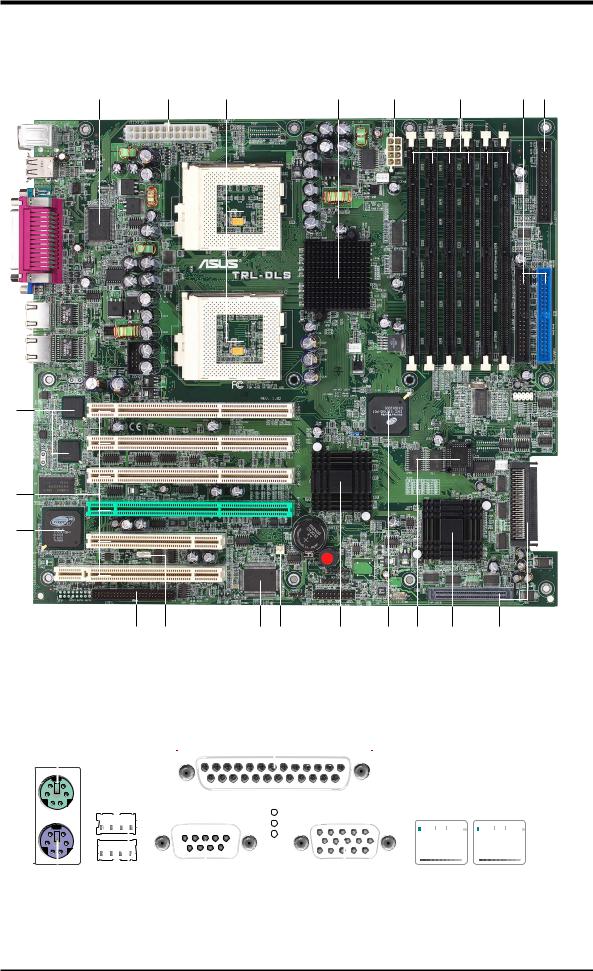
2.FEATURES
2.2.1Component Locations
1 |
2 |
3 |
4 |
5 |
6 |
7 |
8 |
2.FEATURES |
ComponentLocations |
|
|
20
19
18
17 |
16 |
15 14 |
13 |
12 |
11 |
10 |
9 |
21 |
|
|
|
|
|
|
|
22 |
|
|
|
|
|
|
|
|
|
|
|
|
|
|
|
|
|
|
|||||||||||||
|
|
|
|
|
|
|
|
|
|
|
|
|
|
|
|
|
|
|
|
|
|
|
|
|
|
|
|
|
|
|
|
|
|
|
|
|
|
|
|
|
|
|
|
|
|
|
|
|
|
|
|
|
|
|
|
|
|
|
|
|
|
|
|
|
|
|
|
|
|
|
|
|
|
|
|
|
|
|
|
|
|
|
|
|
|
|
|
|
|
|
|
|
|
|
|
|
|
|
|
|
|
|
|
|
|
|
|
|
|
|
|
|
|
|
|
|
|
|
|
|
|
|
|
|
|
|
|
|
|
|
|
|
|
|
|
|
|
|
|
|
|
|
|
|
|
|
|
|
|
|
|
|
|
|
|
|
|
|
|
|
|
|
|
|
|
|
|
|
|
|
|
|
|
|
|
|
|
|
|
|
|
|
|
|
|
|
|
|
|
|
|
|
|
|
|
|
|
|
|
|
|
|
|
|
|
|
|
|
|
|
|
|
|
|
|
|
|
|
|
|
|
|
|
|
|
|
|
|
|
|
|
|
|
|
|
|
|
|
|
|
|
|
|
|
|
|
|
|
|
|
|
|
|
|
|
|
|
|
|
|
|
|
|
|
|
|
|
|
|
|
|
|
|
|
|
|
|
|
|
|
|
|
|
|
|
|
|
|
|
|
|
|
|
|
|
|
|
|
|
|
|
|
|
|
|
|
|
|
|
|
|
|
|
|
|
|
|
|
|
|
|
|
|
|
|
|
|
|
|
|
|
|
|
|
|
|
|
|
|
|
|
|
|
|
|
|
|
|
|
|
|
|
|
|
|
|
|
|
|
|
|
|
|
|
|
|
|
|
|
|
|
|
|
|
|
|
|
|
|
|
|
|
|
|
|
|
|
|
|
|
|
|
|
|
|
|
|
|
|
|
|
|
|
|
|
|
|
|
|
|
|
|
|
|
|
|
|
|
|
|
|
|
|
|
|
|
|
|
|
|
|
|
|
|
|
|
|
|
|
|
|
|
|
|
|
|
|
|
|
|
|
|
|
|
|
|
|
|
|
|
|
|
|
|
|
|
|
|
|
|
|
|
|
|
|
|
|
|
|
|
|
|
|
|
|
|
|
|
|
|
|
|
|
|
|
|
|
|
|
|
|
|
|
|
|
|
|
|
|
|
|
|
|
|
|
|
|
|
|
|
|
|
|
|
|
|
|
|
|
|
|
|
|
|
|
|
|
|
|
|
|
|
|
|
|
|
|
|
|
|
|
|
|
|
|
|
|
|
|
|
|
|
|
|
|
|
|
|
|
|
|
|
|
|
|
|
|
|
|
|
|
|
|
|
|
|
|
|
|
|
|
|
|
|
|
|
|
|
|
|
|
|
|
|
|
|
|
|
|
|
|
|
|
|
|
|
|
|
|
|
|
|
|
|
|
|
|
|
|
|
|
|
|
|
|
|
|
|
|
|
|
|
|
|
|
|
|
|
|
|
|
|
|
|
|
|
|
|
|
|
|
|
|
|
|
|
|
|
|
|
|
|
|
|
|
|
|
|
|
|
|
|
|
|
|
|
|
|
|
|
|
|
|
|
|
|
|
|
|
|
|
|
|
|
|
|
|
|
|
|
|
|
|
|
|
|
|
|
|
|
|
|
|
|
|
|
|
|
|
|
|
|
|
|
|
|
|
|
|
|
|
|
|
|
|
|
|
|
|
|
|
|
|
|
|
|
|
|
|
27 |
26 |
25 |
24 |
23 |
ASUS TRL-DLS User’s Manual |
13 |
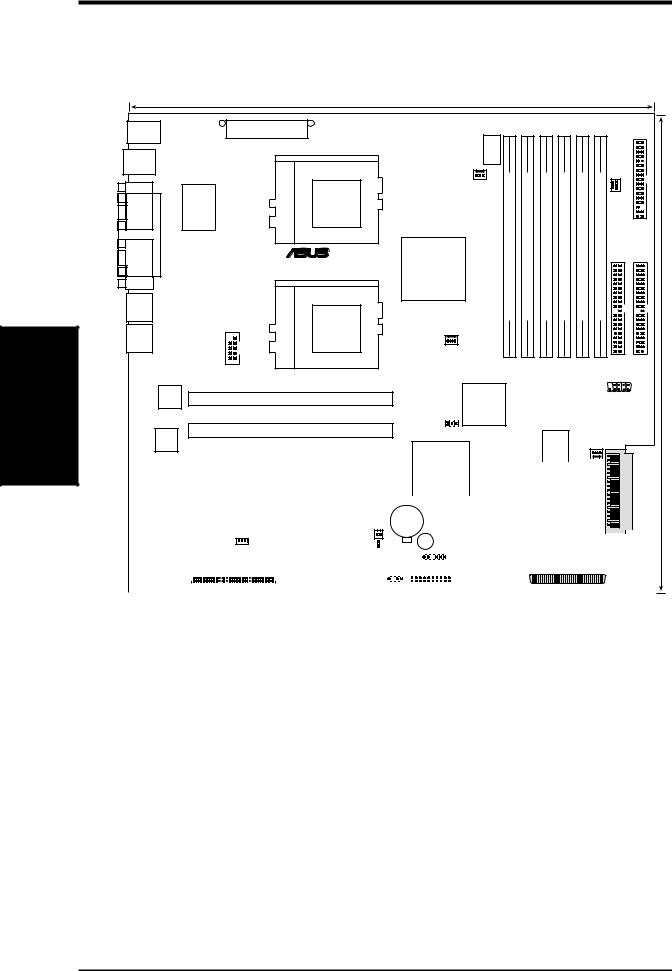
Layout Motherboard
.3 SETUP H/W
3.HARDWARE SETUP
3.1TRL-DLS Motherboard Layout
|
|
|
33.2cm (13.07in) |
|
|
|
|
|
|
|
|
PS/2 |
|
ATX_POWER |
|
|
|
|
|
|
|
|
|
T: Mouse |
|
|
|
|
|
|
|
|
|
|
|
B: Keyboard |
|
|
CON12V |
|
|
|
|
|
|
FLOPPY |
|
USB1 |
|
|
|
|
|
|
|
|
|
||
USB2 |
Super I/O |
370PGA |
|
168bit,-(72A3-pin module) |
168bit,-(72B3-pin module) |
168bit,-(72A2-pin module) |
168bit,-(72B2-pin module) |
168bit,-(72A1-pin module) |
168bit,-(72B1-pin module) |
IDESecondary |
IDEPrimary |
PORTPARALLEL |
CNB20 |
||||||||||
COM1 |
|
|
CPUFAN1 |
|
|
|
|
|
|
SYSFAN2 |
|
|
|
|
|
|
|
|
|
|
|
|
|
|
|
® |
ServerWorks® |
|
|
|
|
|
|
|
|
|
|
|
|
|
|
|
|
|
|
|
|
VGA |
|
TRL-DLS |
HESL |
Socket |
Socket |
Socket |
Socket |
Socket |
Socket |
|
|
|
|
North Bridge |
|
|
|||||||
|
370PGA |
DIMM |
DIMM |
DIMM |
DIMM |
DIMM |
DIMM |
|
(12.08in) |
||
RJ-45 |
|
|
|
||||||||
|
|
|
|
|
|
|
|
|
|
|
|
RJ-45 |
|
|
CPUFAN2 |
|
|
|
|
|
|
|
|
|
|
|
|
|
|
|
|
|
|
30.7cm |
|
|
COM2 |
|
|
|
|
|
|
|
|
|
|
Intel |
|
PCI1 (64-bit, 66MHz 3V) |
ServerWorks® |
|
|
|
|
|
|
USBPORT |
|
Fast |
|
|
|
|
|
|
|
|
|||
|
RCC |
|
|
|
|
|
|
|
|||
Ethernet |
|
|
|
|
|
|
|
|
|
||
|
|
CSB5 |
|
|
|
|
|
|
|
|
|
|
|
|
|
|
|
|
|
|
|
|
|
|
|
|
South Bridge |
|
|
|
|
|
|
|
|
|
|
PCI2 (64-bit, 66MHz 3V) |
P1_66EN |
|
|
|
|
|
|
|
|
Intel |
|
|
|
|
4Mbit |
|
|
|
|
||
Fast |
|
|
|
|
|
|
|
|
|
||
Ethernet |
|
|
|
|
|
Flash |
|
|
|
|
|
|
|
|
|
|
|
BIOS |
|
|
|
|
|
|
|
|
|
PCI3 (64-bit, 66MHz 3V) |
|
|
|
|
|
|
|
|
|
CIOB20 |
|
|
|
|
|
|
|
|
|
|
|
|
|
|
|
||||||||||||||
|
|
|
|
|
|
|
|
|
|
|
|
|
|
|
|
|
|
SYSFAN1 |
|
|
|
||||||||||||||||||||||
|
|
|
|
|
|
|
|
|
|
|
|
|
|
|
|
|
|
|
|
|
|||||||||||||||||||||||
|
|
|
|
|
|
|
|
|
|
|
|
|
|
|
|
|
|
I/O Bridge |
|
|
|
|
|
|
|
|
|
|
|
|
|
|
|
||||||||||
|
|
|
|
|
|
|
|
|
|
|
|
|
|
|
|
|
|
|
|
|
|
|
|
|
|
|
|
|
|||||||||||||||
|
|
|
|
|
|
|
|
|
|
|
|
|
|
|
|
|
|
|
|
|
|
|
|
|
|
|
|
|
|
|
|
|
|
|
|
|
|
||||||
|
|
|
|
PCI4 (64-bit, 66MHz 3V) |
|
|
|
|
|
|
|
|
|
|
|
|
|
|
|
|
|
|
|
|
|
|
|
|
|
|
|
|
|
|
|
|
|
||||||
|
ATI |
|
|
|
|
|
|
|
|
|
|
|
|
|
|
|
|
|
|
|
|
ADAPTEC |
|
|
|
|
|
|
|
|
|
|
|||||||||||
|
|
|
|
|
|
|
|
|
|
|
|
|
|
|
|
|
|
|
|
|
|
|
|
|
|
|
|
|
|
|
|
|
|
|
|
|
|
||||||
|
RAGE XL |
|
|
|
|
|
|
|
|
|
|
|
|
|
|
|
|
|
|
|
|
|
|
|
|
|
|
|
|
|
|
|
|
|
|
|
|
|
|||||
|
|
|
|
|
|
|
|
|
|
|
|
CR2032 3V |
|
|
|
|
|
|
|
|
|
|
|
SCSI |
|
|
|
|
|
|
|
|
|
|
|||||||||
|
VGA |
|
|
|
|
|
|
|
|
|
|
|
|
|
|
|
|
|
|
|
|
|
|
|
|
|
|
|
|
|
|
|
|
||||||||||
|
|
PCI5 (32-bit, 33MHz 5V) |
|
|
|
|
|
|
Lithium Cell |
|
|
|
|
|
|
|
|
|
|
Controller |
|
|
|
|
|
|
|
|
|
|
|||||||||||||
|
Controller |
|
|
|
|
|
|
|
CMOS Power |
|
|
|
|
|
|
|
|
|
|
|
|
|
|
|
|
|
|
|
|
||||||||||||||
|
|
|
|
|
|
WOL_CON |
WOR |
|
|
|
|
|
|
|
|
|
|
|
|
|
BUZZER |
|
|
|
|
|
|
CHB-WIDE |
|
|
|
||||||||||||
|
|
|
|
|
|
|
|
R216 |
|
|
|
|
|
|
|
|
|
|
|
|
|
|
|
|
|
|
|||||||||||||||||
|
|
|
|
PCI6 (32-bit, 33MHz 5V) |
|
ASUS |
|
|
|
|
|
|
|
|
|
|
|
|
|
|
|
SMB |
|
|
|
|
|
|
|
|
|
|
|
|
|
|
|
||||||
|
|
|
|
|
ASIC |
|
|
|
|
|
|
|
|
|
|
|
|
|
|
|
|
CHA-WIDE |
|
|
|
|
|
|
|
|
|
|
|||||||||||
|
|
|
|
ERMC |
with Hardware |
|
|
|
|
|
|
|
|
|
|
|
|
|
|
|
|
|
|
|
|
|
|
|
|
|
|
|
|
|
|||||||||
|
|
|
|
Monitor |
|
|
|
|
|
|
|
|
|
|
|
|
|
|
|
|
|
|
|
|
|
|
|
|
|
|
|
|
|
|
|
|
|
||||||
|
|
|
|
|
|
|
|
|
|
|
|
|
|
|
|
|
|
|
|
PANEL |
|
34 |
|
|
|
|
|
1 |
|
|
|
|
|
|
|||||||||
|
|
|
|
|
|
|
|
|
|
|
|
|
|
|
|
|
|
|
|
|
|
|
|
|
|
|
|
68 |
|
|
|
|
|
35 |
|
|
|
|
|
|
|||
|
|
|
|
|
|
|
|
|
|
CHASSIS |
|
|
|
|
|
|
|
|
|
|
|
|
|
|
|
|
|
|
|
|
|
|
|
|
|
|
|
||||||
|
|
|
|
|
|
|
|
|
|
|
|
|
|
|
|
|
|
|
|
|
|
|
|
|
|
|
|
|
|
|
|
|
|
|
|
|
|
|
|
|
|
|
|
NOTE: The SCSI and eRMC components are optional. These are grayed out in the above motherboard layout.
14 |
ASUS TRL-DLS User’s Manual |

3.HARDWARE SETUP
3.2Layout Contents
Jumper
1) P1_66EN p. 16 PCI Slot Setting
Expansion Slots
1) |
DIMMB1/2/3 |
p. 17 |
168-Pin System Memory Support |
|
DIMMA1/2/3 |
|
|
2) |
CPU |
p. 19 |
Central Processing Unit (CPU) |
3) |
PCI66-1/2/3/4 |
p. 21 |
64-bit PCI Bus Expansion Slots |
|
PCI5, PCI6 |
p. 21 32-bit PCI Bus Expansion Slots |
|
Connectors
1) |
IDE1/IDE2 |
p. 24 |
Primary/Secondary IDE Connectors (two 40-1 pin) |
2 |
FLOPPY |
p. 25 |
Floppy Disk Drive Connector (34-1 pin) |
3) |
WOL_CON |
p. 25 |
Wake-On-LAN Connector (3-pin) |
4) |
WOR |
p. 26 |
Wake-On-Ring Connector (2-pin) |
5) |
CHASSIS |
p. 26 |
Chassis Open Alarm Lead (4-1 pin) |
6) |
CHA-WIDE, |
p. 27 |
68-pin Ultra160 SCSI Connectors (two 68-pin) |
|
CHB-WIDE |
|
|
7) |
CPUFAN1/2 |
p. 28 |
CPU Fan Connectors (two 3-pin) |
|
SYSFAN1/2 |
p. 28 |
System Fan Connectors (two 3-pin) |
8) |
SMB |
p. 29 |
SMBus Connector (6-1 pins) |
9) |
eRMC |
p. 29 |
ASUS Server Management Card Connector |
|
|
|
(50-pin) |
10) |
ATXPWR, |
p. 30 |
ATX Power Supply Connector (20/24-pin) |
|
CON12V |
p. 30 |
12V Power Supply Connector (8-pin) |
11) |
COM2 |
p. 31 |
Serial Port 2 (10-1 pin) |
12) |
PCI66-4 |
p. 31 |
Zero-channel RAID slot |
13) |
USBPORT |
p. 32 |
Universal Serial Port Header (10-1pin male) |
14) |
PANEL |
|
|
|
- NIC |
p. 33 |
NIC Activity LED (2-pin) |
|
- STATUS |
p. 33 |
Status Activity LED (2-pin) |
|
- PWRSW |
p. 33 |
ATX Power Switch/Soft Off Lead (2-pin) |
|
- RESET |
p. 33 |
Reset Switch Lead (2-pin) |
|
- PWR.LED |
p. 33 |
System Power LED Lead (3-1 pin) |
|
- NMI |
p. 33 |
Non-Mask Interrupt Switch (2-pin) |
|
- SPEAKER |
p. 33 |
System Warning Speaker Connector (4-pin) |
|
- IDELED |
p. 33 |
IDE/SCSI Activity LED (2-pin) |
Layout Contents
3. H/W SETUP
ASUS TRL-DLS User’s Manual |
15 |
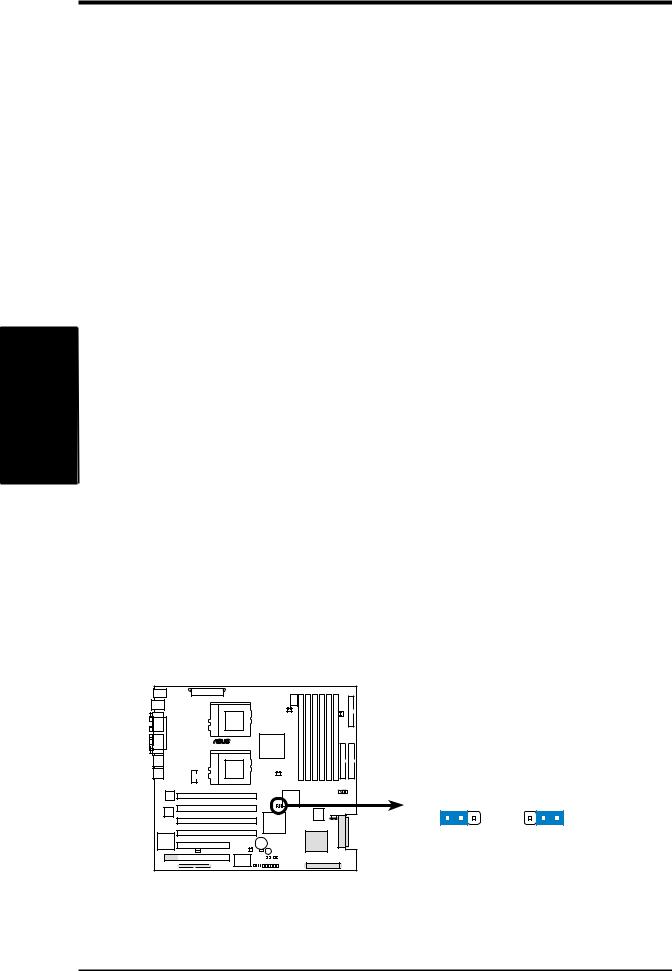
3.HARDWARE SETUP
3.3Hardware Setup Procedure
SETUP H/W .3
Jumper
Complete the following steps before using your computer:
1.Check motherboard settings
2.Install memory modules
3.Install the Central Processing Unit (CPU)
4.Install a CPU terminator, if you installed only one CPU.
5.Install Expansion Cards
6.Connect ribbon cables, panel wires, and power supply cables
7.Configure the BIOS parameter settings
Take note of the following precautions before you install motherboard components or change any motherboard settings.
1.Unplug the power cord from the wall socket before touching any internal component.
2.Use a grounded wrist strap or touch a safely grounded object, such as the power supply case, before handling components to avoid damaging them due to static electricity.
3.Hold components by the edges and do not touch the ICs on them.
4.Whenever you uninstall any component, place the components on a grounded antistatic pad or in the bag that came with the component.
5.Before you install or remove any component, ensure that the ATX power supply is switched off or the power cord is detached from the power supply. Failure to do so may cause severe damage to the motherboard, peripherals, and/or components.
3.4Jumper Settings
There is only one jumper on the motherboard. This jumper allows you to set the speed for the PCI slots.
TRL-DLS |
P1_66EN
1 |
2 |
2 |
3 |
Normal |
Force 33Mhz |
||
(Default) |
|
|
|
TRL-DLS PCI Slot Setting
16 |
ASUS TRL-DLS User’s Manual |

3.HARDWARE SETUP
3.5System Memory
This motherboard uses interleaved PC133 Dual Inline Memory Modules (DIMMs). Six DIMM sockets are available for 3.3Volt (power level) registered Synchronous Dynamic Random Access Memory (SDRAM) of 16MB, 32MB, 64MB, 128MB, 256MB, 512MB, or 1GB densities with Serial Presence Detect (SPD) and Error Check and Correction (ECC).
The motherboard supports system memory of up to 6GB in a two-way interleaved configuration. This configuration requires that you install identical DIMMs (exactly the same type and size) in pairs. For example, if you installed a 512MB module into DIMMA1, you must install the same type of 512MB module into DIMMB1. The same rule applies to pairs DIMMA2/DIMMB2 and DIMMA3/DIMMB3.
The following table lists the DIMM socket pairs and the memory modules you can install.
3.5.1 Memory Configurations
DIMM Socket |
168-pin DIMM |
Total Memory |
DIMMB1 |
SDRAM 128MB, 256MB, 512MB, 1GB |
x1 |
|
|
|
DIMMA1 |
SDRAM 128MB, 256MB, 512MB, 1GB |
x1 |
|
|
|
DIMMB2 |
SDRAM 128MB, 256MB, 512MB, 1GB |
x1 |
|
|
|
DIMMA2 |
SDRAM 128MB, 256MB, 512MB, 1GB |
x1 |
|
|
|
DIMMB3 |
SDRAM 128MB, 256MB, 512MB, 1GB |
x1 |
|
|
|
DIMMA3 |
SDRAM 128MB, 256MB, 512MB, 1GB |
x1 |
|
|
|
|
Total System Memory (Max. 6GB) |
= |
|
|
|
IMPORTANT: The system chipset only supports 64Mbit, 128Mbit, and 256Mbit “ registered” SDRAMs with ECC. Make sure to use only the specified DIMM types for smooth system operation.
System Memory
3. H/W SETUP
ASUS TRL-DLS User’s Manual |
17 |
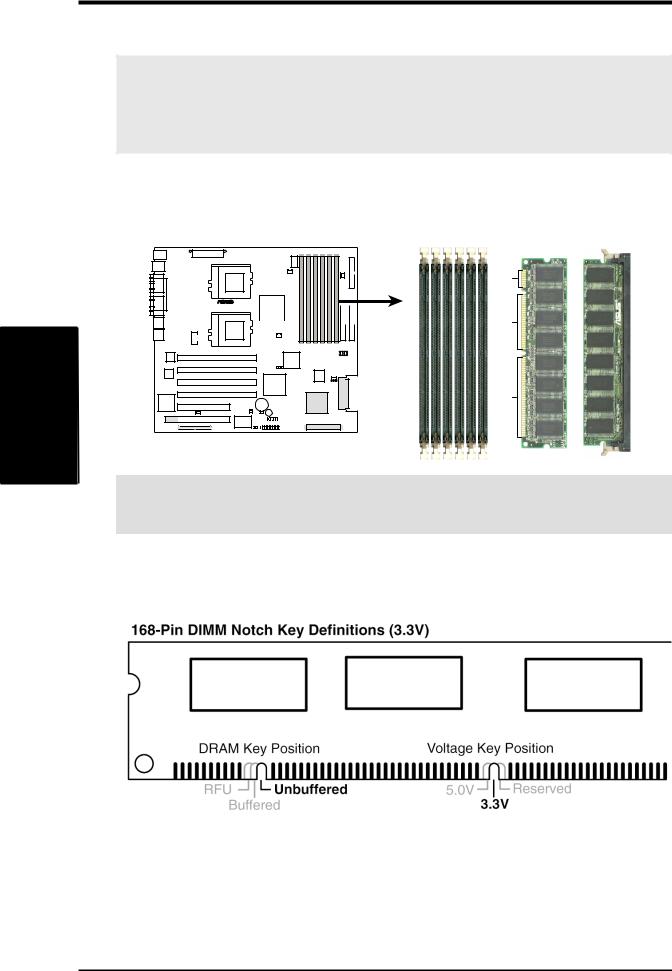
System |
3.H/W |
Memory |
SETUP |
3.HARDWARE SETUP
3.5.2Memory Installation
WARNING! Make sure that you unplug the power supply when adding or removing memory modules or other system components. Failure to do so may cause severe damage to both the motherboard and expansion cards (see 3.3 Hardware Setup Procedure for more information).
Insert a DIMM into the DIMM socket as shown. Because the number of pins are different on either side of the breaks, the module only fits in one direction. SDRAM DIMMs have different pin contacts on each side.
Pins20
TRL-DLS 

 Pins
Pins
60
88 Pins
TRL-DLS 168-Pin DIMM Sockets
IMPORTANT: Always install DIMMs in pairs. See previous section for the memory configurations.
Use only 3.3Volt “ registered” SDRAM DIMMs. To determine the DIMM type, check the notches on the DIMMs (see the figure below).
The notches on the DIMM shifts between left, center, or right to identify the type and also to prevent the wrong type from being inserted into the DIMM slot on the motherboard. You must tell your retailer the correct DIMM type before purchasing. This motherboard supports four clock signals per DIMM.
18 |
ASUS TRL-DLS User’s Manual |
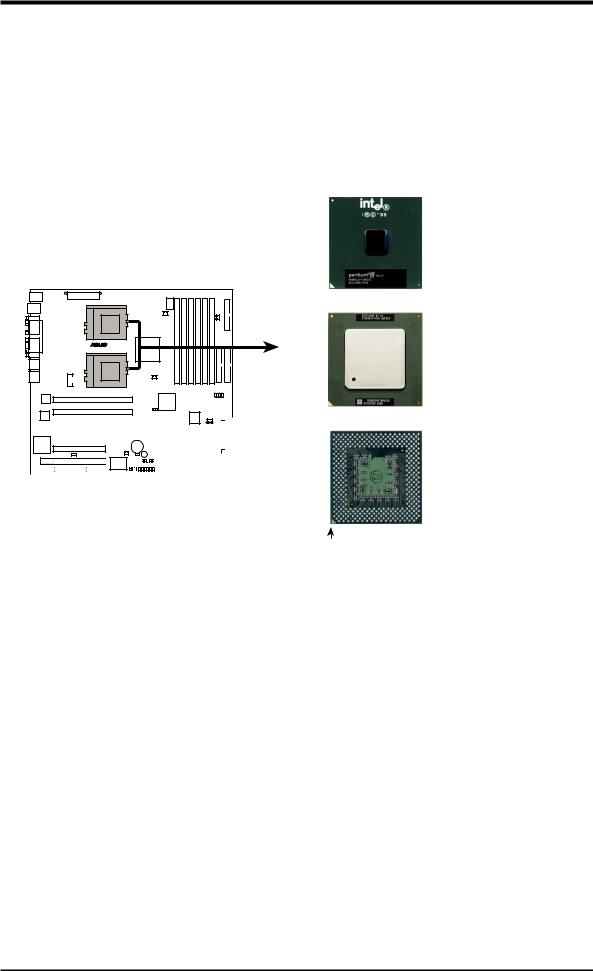
3.HARDWARE SETUP
3.6Central Processing Unit (CPU)
The motherboard comes with a dual Socket 370 for Intel Pentium III Coppermine (256KB L2 cache) and Tualatin (512KB L2 cache) CPUs running up to 1.53+GHz with 133MHz Front Side Bus (FSB). The following illustration shows the location of the CPU sockets on the motherboard, and the correct CPU and terminator orientation.
Pentium III (Coppermine)
FC-PGA
Gold Arrow 
Pentium III (Tualatin)
TRL-DLS
FC-PGA2
Gold Arrow 
|
|
|
|
|
|
|
|
|
|
|
|
|
|
Socket 370 |
|
|
|
|
|
|
|
|
|
|
|
|
|
|
|
|
|
|
|
|
|
|
|
|
|
|
|
|
|
|
|
|
|
|
|
|
|
|
|
|
|
|
|
|
|
|
|
|
|
|
|
|
|
|
|
|
|
|
|
|
|
|
|
|
|
|
|
|
|
|
|
|
|
|
|
|
|
|
|
|
|
|
|
|
|
|
|
|
|
|
|
|
|
|
|
|
|
|
|
|
|
|
|
|
Terminator |
|
|
|
|
|
|
|
|
|
|
|
|
|
|
|
TRL-DLS Socket 370 |
(Use when only one |
|||||||||||||
CPU is installed) |
||||||||||||||
Silver Arrow
Note in the illustration that the CPU and the terminator have marks (usually a notch or a gold mark on one corner) to help you identify the proper orientation and enable you to correctly install them. It is important that you match the marked corner of the CPU and terminator with the corresponding corner on the socket so as not to damage the CPU pins.
H/WSETUP |
CPU |
3. |
|
|
|
ASUS TRL-DLS User’s Manual |
19 |
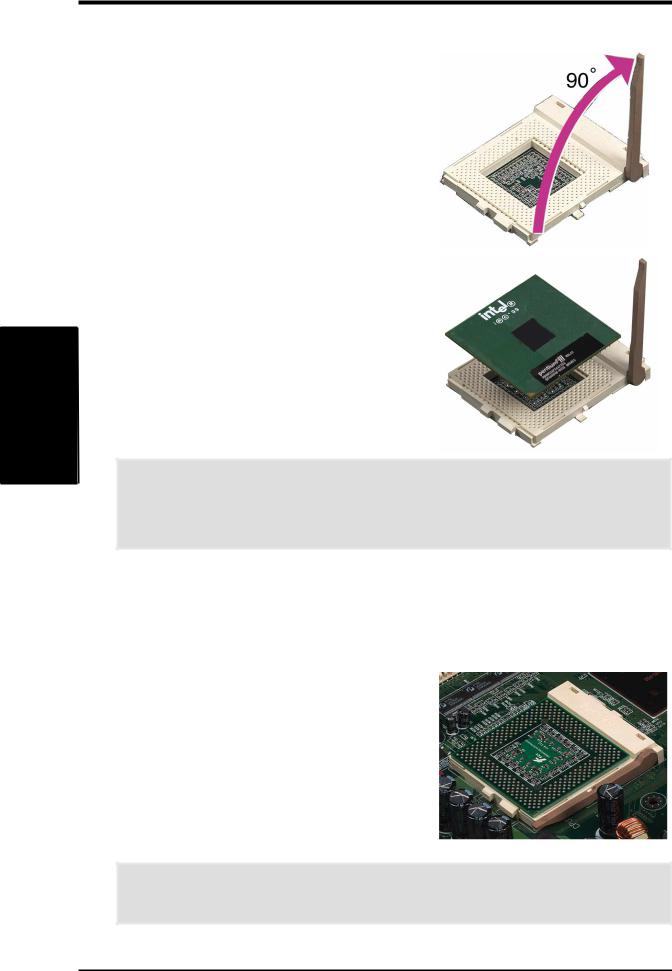
3CPU H/W . SETUPInstallation
3.HARDWARE SETUP
3.6.1Installing the CPU and Terminator
Follow these steps to install a CPU.
1.Locate the ZIF socket on the motherboard.
2.Unlock the socket by pressing the lever sideways then lifting it up to a 90°-100° angle.
3.Position the CPU above the socket such that its notched or marked corner matches the socket corner near the end of the lever, while making sure that the CPU is parallel to the socket.
4.Carefully insert the CPU into the socket until it fits in place.
CAUTION! The CPU fits only in one orientation. Do not force the CPU into the socket to prevent bending the pins and damaging the CPU. If the CPU does not fit completely, check its orientation or check for bent pins.
5.When the CPU is in place, press it firmly on the socket while you push down the socket lever to secure the CPU. The lever clicks on the socket indicating that it is locked.
6.Install a CPU heatsink. Refer to the documentation that came with the heatsink.
7.Install the CPU terminator the same way as you would install a CPU. The figure on the right shows an installed CPU terminator.
CAUTION! DO NOT install a heatsink on the terminator! It will damage the motherboard!
20 |
ASUS TRL-DLS User’s Manual |

3.HARDWARE SETUP
3.7Expansion Slots
WARNING! Unplug the power supply when adding or removing expansion cards or other system components. Failure to do so may cause severe damage to both your motherboard and expansion cards.
In the future, you may need to install expansion cards. The motherboard has four 3.3V 64-bit/66MHz PCI slots and two 5V 32-bit/33MHz PCI slots. The slots support PCI 2.2 protocol.
3.7.1 Expansion Card Installation Procedure
Follow these steps to install an expansion card.
1.Before installing the expansion card, read the documentation that came with it and make the necessary hardware settings for the card.
2.Remove the system unit cover (if your motherboard is already installed in a chassis).
3.Remove the bracket opposite the slot that you intend to use. Keep the screw for later use.
4.Align the card connector with the slot and press firmly until the card is completely seated on the slot.
5.Secure the card to the chassis with the screw you removed earlier.
6.Replace the system cover.
3.7.2 Configuring an Expansion Card
After physically installing the expansion card, configure the card by adjusting the software settings.
1.Turn on the system and change the necessary BIOS settings, if any. See Chapter 4 for information on BIOS setup.
2.Assign an IRQ to the card. Refer to the tables on the next page.
3.Install the software drivers for the expansion card.
Expansion Cards
3. H/W SETUP
ASUS TRL-DLS User’s Manual |
21 |

3Expansion
H/W .
SETUPCards
3. HARDWARE SETUP
The following table lists the default IRQ assignments for standard PC devices. Use this table when configuring your system and for resolving IRQ conflicts.
ISA Interrupt (IRQ) Assignments
ISA INT |
Priority |
Standard Function |
ISA 00 |
1 |
System Timer |
ISA 01 |
2 |
Keyboard Controller |
ISA 02 |
N/A |
Programmable Interrupt |
ISA 03* |
11 |
Communications Port (COM2) |
ISA 04* |
12 |
Communications Port (COM1) |
ISA 05* |
13 |
Sound Card (sometimes LPT2) |
ISA 06 |
14 |
Floppy Disk Controller |
ISA 07* |
15 |
Printer Port (LPT1) |
ISA 08 |
3 |
System CMOS/Real Time Clock |
ISA 09* |
4 |
ACPI Mode when used |
|
|
|
ISA 10* |
5 |
IRQ Holder for PCI Steering |
|
|
|
ISA 11* |
6 |
IRQ Holder for PCI Steering |
|
|
|
ISA 12* |
7 |
PS/2 Compatible Mouse Port |
ISA 13 |
8 |
Numeric Data Processor |
ISA 14* |
9 |
Primary IDE Channel |
ISA 15* |
10 |
Secondary IDE Channel |
*These IRQs are usually available for PCI devices.
PCI Interrupt (IRQ) Assignments
PCI Slot |
PCI INTA |
PCI INTB |
PCI INTC |
PCI INTD |
1 (64-bit) |
PCI 1 |
PCI 12 |
PCI 13 |
PCI 14 |
2 (64-bit) |
PCI 4 |
PCI 15 |
PCI 16 |
PCI 17 |
3 (64-bit) |
PCI 5 |
PCI 18 |
PCI 19 |
PCI 20 |
4 (64-bit) |
PCI 8 |
PCI 21 |
PCI 22 |
PCI 23 |
5 (32-bit) |
PCI 9 |
PCI 24 |
PCI 25 |
PCI 26 |
6 (32-bit) |
PCI 10 |
PCI 27 |
PCI 28 |
PCI 29 |
22 |
ASUS TRL-DLS User’s Manual |
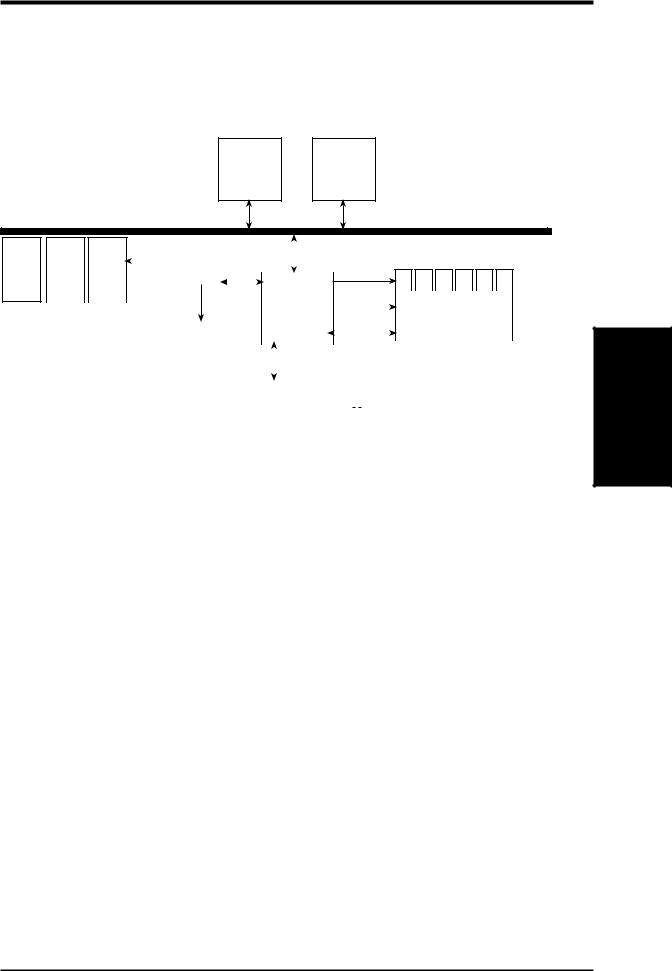
3.HARDWARE SETUP
3.7.3PCI Configuration Diagram
Peer-to-Peer PCI Bus Configuration Diagram
Peer-to-Peer PCI Bus
Configuration Diagram
Socket 370 |
Socket 370 |
PCI-1 |
PCI-2 |
PCI-3 |
Secondary |
RCC |
|
|
|
|
|
|
|
|
|
||||||||
|
CIOB20 |
|
|
|
||||||
PCI Bus |
|
|
MA |
|||||||
64-bit |
64-bit |
64-bit |
(66/33MHz) |
|
|
IMB |
|
|
||
|
|
|||||||||
|
|
|
|
|
|
|
|
|
|
|
|
|
|
|
|
|
|
|
|
|
|
|
RCC |
|
|
|
Cntl |
|
|
|
|
|
|
133 MHz |
|
|
|
|||||||||||||
|
|
|
|
|
|
|
|
|
|
|
|
|
|
|
|
|
|
|
|
|
|
|
|||||||||||||||||
Third PCI Bus (66/33MHz) |
CNB20HE-SL |
|
|
MD |
|
|
Registered DIMM |
||||||||||||||||||||||||||||||||
|
|
|
|
|
|
|
|
|
|
|
|
|
|
|
|
|
|
|
|
|
|
|
|
|
|
|
|
|
|
|
|
|
|
|
|
||||
|
|
|
|
|
|
|
|
|
|
|
|
|
|
|
|
|
|
|
|
|
|
|
|
|
|
|
|
|
|
|
|
|
|
|
|||||
|
|
|
|
|
|
|
|
|
|
|
|
|
|
|
|
|
133MHz |
|
|
|
|
|
|
|
|
|
|
|
|
|
|
|
|
|
|
||||
|
|
|
|
|
|
|
|
|
|
|
|
|
|
|
|
|
|
|
|
|
|
|
|
|
|
|
|
|
|
|
|
|
|
|
|||||
|
|
|
|
|
|
|
|
|
|
|
|
|
|
|
|
|
|
|
|
|
|
|
|
|
|
|
|
|
|
|
|
|
|
|
|
|
|
|
|
|
|
|
|
|
Adaptec SCSI |
|
|
|
|
Primary PCI Bus (33MHz) |
|
|
|
|
|
|
|
|
|||||||||||||||||||||
|
|
PCI-4 |
|
|
7899W |
|
|
|
|
|
|
|
|
|
|
|
|
||||||||||||||||||||||
|
|
|
|
|
|
|
|
|
|
|
|
|
|
|
|
|
|
|
|
|
|
|
|
|
|
|
|
|
|
|
|
|
|
|
|
|
|
||
|
|
64-bit |
|
|
|
|
|
|
|
|
|
|
|
|
|
|
|
|
|
|
|
|
|
|
|
|
|
|
|
|
|
|
|
|
|
|
|
|
|
|
|
|
|
|
|
|
|
|
|
|
|
|
|
|
|
|
|
|
|
|
|
|
|
|
|
|
|
|
|
|
|
|
|
|
|
||||
|
|
|
|
|
|
|
|
|
|
RCC |
|
Intel |
|
|
|
|
|
|
|
|
|
|
|
|
|
|
|
|
Intel |
ATI |
|
||||||||
|
|
|
|
|
|
|
|
|
|
|
|
|
|
|
|
|
|
|
|
|
|
|
|
|
|
|
|
||||||||||||
|
|
|
|
|
|
|
|
|
|
|
82550 |
|
|
PCI-5 |
|
|
PCI-6 |
|
|
82550 |
|
||||||||||||||||||
|
|
|
|
|
|
|
|
|
|
CSB5 |
|
|
|
|
|
|
|
Rage-XL |
|
||||||||||||||||||||
|
|
|
|
|
|
|
|
|
|
|
(1) |
|
|
|
|
|
|
(2) |
|
|
|||||||||||||||||||
|
|
|
|
|
|
|
|
|
|
|
|
|
|
|
|
32-bit |
|
|
32-bit |
|
|
|
|
|
|
||||||||||||||
|
|
|
|
|
|
|
|
|
|
|
|
|
|
|
|
|
|
|
|
|
|
|
|
|
|
|
|
|
|
|
|||||||||
|
|
|
|
|
|
|
|
|
|
|
|
|
|
|
|
|
|
|
|
|
|
|
|
|
|
|
|
|
|
|
|
|
|
|
|
|
|
|
|
|
|
|
|
|
|
|
|
|
|
|
|
|
|
|
|
|
|
|
|
|
|
|
|
|
|
|
|
|
|
|
|
|
|
|
|
|
|
|
|
Expansion Cards
3. H/W SETUP
ASUS TRL-DLS User’s Manual |
23 |
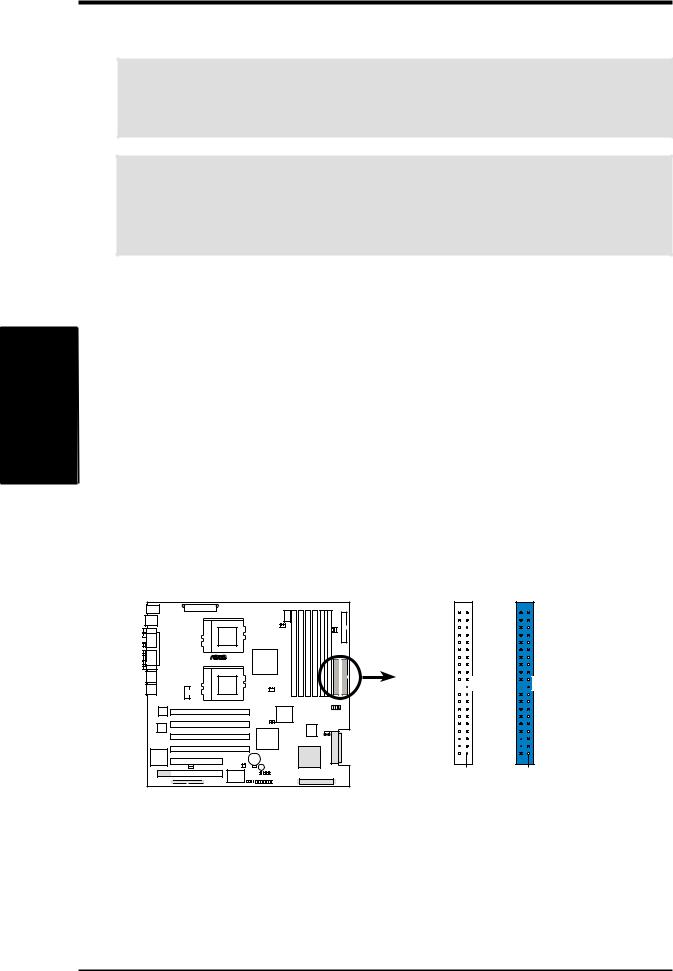
3.HARDWARE SETUP
3.8Connectors
.3 H/WConnectors SETUP
WARNING! Some pins are used for connectors or power sources. These are clearly distinguished from jumpers in the Motherboard Layout. Placing jumper caps over these connector pins will cause damage to your motherboard.
IMPORTANT: Always connect ribbon cables such that the red stripe matches Pin 1 on the connector. Pin 1 is usually on the side closest to the power connector on hard disk drives and CD-ROM drives, but may be on the opposite side on floppy disk drives.
1)IDE Connectors (40-1 pin PRIMARY/SECONDARY)
These connectors support ATA-100 IDE hard disks. Use IDE ribbon cables to connect the master and slave devices to these connectors. If you install two hard disks, you must configure the second drive as a slave device by setting its jumper accordingly. Refer to the hard disk documentation for the jumper settings. BIOS supports specific device bootup (see 4.6. Boot Menu).
NOTE: Pin 20 on each IDE connector is removed to match the covered hole on the ATA-100 cable connector. This prevents incorrect orientation when you connect the cables.
TIP: You may configure two hard disks to be both Masters with two ribbon cables –one for the primary IDE connector and another for the secondary IDE connector.
TRL-DLS |
Secondary IDE Connector
|
Primary IDE Connector |
PIN 1 |
PIN 1 |
TRL-DLS IDE Connectors
NOTE: Orient the red markings (usually zigzag) on the IDE ribbon cable to PIN 1.
24 |
ASUS TRL-DLS User’s Manual |
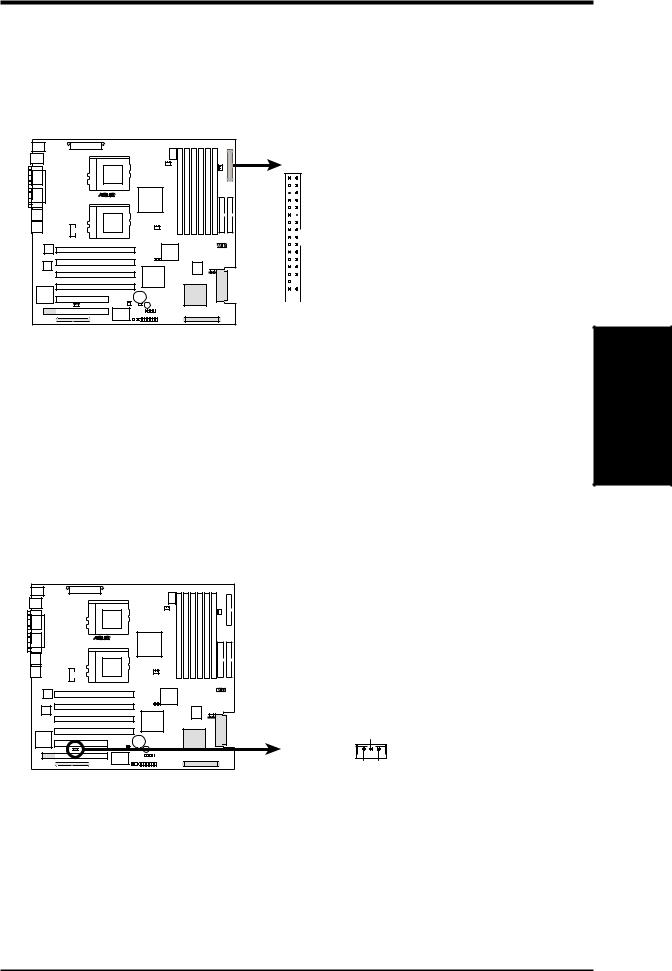
3.HARDWARE SETUP
2)Floppy Disk Drive Connector (34-1 pin FLOPPY)
This connector supports the provided floppy drive ribbon cable. After connecting the single end to the board, connect the two plugs on the other end to the floppy drives. (Pin 5 is removed to prevent inserting in the wrong orientation when using ribbon cables with pin 5 plugged).
TRL-DLS |
NOTE: Orient the red markings on the floppy ribbon cable to PIN 1.
 PIN 1
PIN 1
TRL-DLS Floppy Disk Drive Connector
3)Wake-On-LAN Connector (3-pin WOL_CON)
This connector supports a LAN card with a Wake-On-LAN output. The connector powers up the system when a wakeup packet or signal is received through the LAN card.
IMPORTANT: This feature requires that the BIOS item Onboard LAN Power Up is enabled (see 4.5.1 Power Up Control) and that your system has an ATX power supply with at least 720mA +5V standby power.
3. H/W SETUP
Connectors
TRL-DLS |
IMPORTANT: Requires an ATX power supply with at least 720mA +5 volt standby power
WOL_CON
Ground
PME +5 Volt Standby
TRL-DLS Wake-On-LAN Connector
ASUS TRL-DLS User’s Manual |
25 |
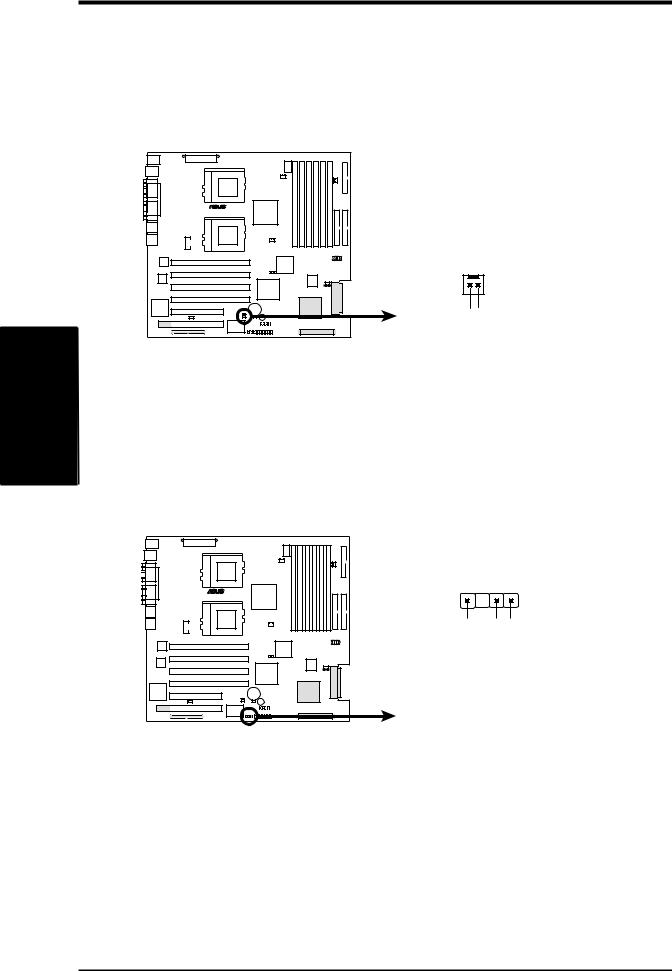
Connectors
SETUP H/W .3
3.HARDWARE SETUP
4)Wake-On-Ring Connector (2-pin WOR)
This connector connects to internal modem cards with a Wake-On-Ring output. The connector powers up the system when a ringup packet or signal is received through the internal modem card. NOTE: For external modems, Wake-On-Ring is detected through the COM port.
TRL-DLS |
|
WOR |
|
1 |
2 |
Ground Ring#
TRL-DLS Wake-On-Ring Connector
5)Chassis Intrusion Connector (CHASSIS)
This connector is designed for chassis intrusion detection. This requires an external detection mechanism such as a chassis intrusion sensor or microswitch. When any chassis component is removed, the sensor triggers and sends a highlevel signal to this connector to record a chassis intrusion event.
CHASSIS
TRL-DLS |
|
+5Volt Supply Stand By) |
Chassis Signal Ground |
TRL-DLS Chassis Intrusion Lead |
(Power |
|
|
|
26 |
ASUS TRL-DLS User’s Manual |
